Data Science Mastery
Build a future-proof career with our industry-driven data science course. This hands-on program takes you from beginner to advanced levels and prepares you for top-tier jobs with a recognized data scientist certification course.
Level : Intermediate
Duration :180 hrs
Rating : 4.9/5
Language : Python
Activate this Course for :
₹ 21999
21999
Activate this Course for :
₹ 22999
22999
Enter Details
Data Science Mastery Course Overview
Analyze and visualize data using Python, Pandas, and Matplotlib
Work with machine learning algorithms for classification, regression, and clustering
Build data models, evaluate performance, and deploy solutions
Apply concepts in AI, deep learning, and big data
Get job-ready with resume support, interview prep, and capstone projects
Data Science Mastery Course Includes
Certification After completing the courses
We Provides 24/7 Dedicated Forum Support
Accessing to AI tools to enhance coding skills
Enjoy Lifetime access to course materials
Assessments to track your progress
Data Science Mastery Course Contents
-
1.1.What is Data Science?
-
1.2.Lifecycle of Data Science Projects
-
1.3.Applications and Use Cases
-
1.4.Roles: Data Analyst vs Scientist vs Engineer
-
1.1.What is Data Science?
-
1.2.Lifecycle of Data Science Projects
-
1.3.Applications and Use Cases
-
1.4.Roles: Data Analyst vs Scientist vs Engineer
-
2.1.Python Refresher (Data types, Loops, Functions)
-
2.2.List Comprehensions
-
2.3.Working with Jupyter Notebooks
-
2.4.Importing Libraries
-
2.1.Python Refresher (Data types, Loops, Functions)
-
2.2.List Comprehensions
-
2.3.Working with Jupyter Notebooks
-
2.4.Importing Libraries
-
3.1.Creating and Manipulating Arrays
-
3.2.Array Indexing and Slicing
-
3.3.Broadcasting and Vectorization
-
3.4.Mathematical Operations with NumPy
-
3.1.Creating and Manipulating Arrays
-
3.2.Array Indexing and Slicing
-
3.3.Broadcasting and Vectorization
-
3.4.Mathematical Operations with NumPy
-
4.1.DataFrames and Series
-
4.2.Reading and Writing CSV/Excel Files
-
4.3.Filtering, Sorting, GroupBy
-
4.4.Handling Missing Data
-
4.1.DataFrames and Series
-
4.2.Reading and Writing CSV/Excel Files
-
4.3.Filtering, Sorting, GroupBy
-
4.4.Handling Missing Data
-
5.1.Line, Bar, Pie, Histogram Plots
-
5.2.Customizing Plots
-
5.3.Seaborn: Countplot, Boxplot, Heatmap
-
5.4.Visual Data Analysis
-
5.1.Line, Bar, Pie, Histogram Plots
-
5.2.Customizing Plots
-
5.3.Seaborn: Countplot, Boxplot, Heatmap
-
5.4.Visual Data Analysis
-
6.1.Handling Duplicates and Missing Values
-
6.2.Data Transformation
-
6.3.Feature Scaling and Encoding
-
6.4.Outlier Detection
-
6.1.Handling Duplicates and Missing Values
-
6.2.Data Transformation
-
6.3.Feature Scaling and Encoding
-
6.4.Outlier Detection
-
7.1.Univariate, Bivariate, Multivariate Analysis
-
7.2.Correlation Matrix and Pair Plots
-
7.3.Statistical Summaries
-
7.4.EDA Reporting
-
7.1.Univariate, Bivariate, Multivariate Analysis
-
7.2.Correlation Matrix and Pair Plots
-
7.3.Statistical Summaries
-
7.4.EDA Reporting
-
8.1.Descriptive Statistics
-
8.2.Probability Distributions
-
8.3.Sampling Techniques
-
8.4.Inferential Statistics (Hypothesis Testing)
-
8.1.Descriptive Statistics
-
8.2.Probability Distributions
-
8.3.Sampling Techniques
-
8.4.Inferential Statistics (Hypothesis Testing)
-
9.1.Linear Algebra for Data (Vectors, Matrices)
-
9.2.Calculus Basics
-
9.3.Matrix Multiplication and Operations
-
9.4.Gradient Concept for ML
-
9.1.Linear Algebra for Data (Vectors, Matrices)
-
9.2.Calculus Basics
-
9.3.Matrix Multiplication and Operations
-
9.4.Gradient Concept for ML
-
10.1.Types of ML: Supervised, Unsupervised, Reinforcement
-
10.2.Steps in Model Building
-
10.3.Overview of Training and Testing
-
10.1.Types of ML: Supervised, Unsupervised, Reinforcement
-
10.2.Steps in Model Building
-
10.3.Overview of Training and Testing
-
11.1.Linear Regression, Polynomial Regression
-
11.2.Evaluation Metrics: MAE, MSE, RMSE, R2
-
11.3.Scikit-learn Implementation
-
11.1.Linear Regression, Polynomial Regression
-
11.2.Evaluation Metrics: MAE, MSE, RMSE, R2
-
11.3.Scikit-learn Implementation
-
12.1.Logistic Regression, KNN, Decision Tree, Random Forest
-
12.2.Confusion Matrix, Accuracy, Precision, Recall, F1
-
12.3.ROC and AUC
-
12.1.Logistic Regression, KNN, Decision Tree, Random Forest
-
12.2.Confusion Matrix, Accuracy, Precision, Recall, F1
-
12.3.ROC and AUC
-
13.1.K-Means Clustering, Hierarchical Clustering
-
13.2.Dimensionality Reduction: PCA
-
13.3.Elbow Method and Silhouette Score
-
13.1.K-Means Clustering, Hierarchical Clustering
-
13.2.Dimensionality Reduction: PCA
-
13.3.Elbow Method and Silhouette Score
-
14.1.Train/Test Split and Cross Validation
-
14.2.Overfitting vs Underfitting
-
14.3.Hyperparameter Tuning (Grid Search, Random Search)
-
14.1.Train/Test Split and Cross Validation
-
14.2.Overfitting vs Underfitting
-
14.3.Hyperparameter Tuning (Grid Search, Random Search)
-
15.1.Importing and Cleaning Datasets
-
15.2.Applying EDA and Preprocessing
-
15.3.Model Selection and Evaluation
-
15.1.Importing and Cleaning Datasets
-
15.2.Applying EDA and Preprocessing
-
15.3.Model Selection and Evaluation
-
16.1.Text Cleaning: Tokenization, Lemmatization, Stopwords
-
16.2.Bag of Words and TF-IDF
-
16.3.Sentiment Analysis and WordCloud
-
16.1.Text Cleaning: Tokenization, Lemmatization, Stopwords
-
16.2.Bag of Words and TF-IDF
-
16.3.Sentiment Analysis and WordCloud
-
17.1.Time Series Components
-
17.2.Plotting and Decomposing
-
17.3.Moving Average and Exponential Smoothing
-
17.4.Introduction to ARIMA
-
17.1.Time Series Components
-
17.2.Plotting and Decomposing
-
17.3.Moving Average and Exponential Smoothing
-
17.4.Introduction to ARIMA
-
18.1.What is Deep Learning?
-
18.2.Introduction to Neural Networks
-
18.3.Keras Sequential API
-
18.4.Building and Evaluating Basic Models
-
18.1.What is Deep Learning?
-
18.2.Introduction to Neural Networks
-
18.3.Keras Sequential API
-
18.4.Building and Evaluating Basic Models
-
19.1.Choose a Dataset
-
19.2.Define the Problem Statement
-
19.3.Data Cleaning, EDA, Model Building
-
19.4.Final Report and Presentation
-
19.1.Choose a Dataset
-
19.2.Define the Problem Statement
-
19.3.Data Cleaning, EDA, Model Building
-
19.4.Final Report and Presentation
-
20.1.Advanced Dataset Integration
-
20.2.Deploying ML Model with Streamlit or Flask
-
20.3.End-to-End Solution Presentation
-
20.1.Advanced Dataset Integration
-
20.2.Deploying ML Model with Streamlit or Flask
-
20.3.End-to-End Solution Presentation
Benefits
Our Dashboard offers 1500+ coding problems to sharpen skills and prepare for company-specific interviews. Track progress, build your profile, and boost job-readiness for successful technical interviews
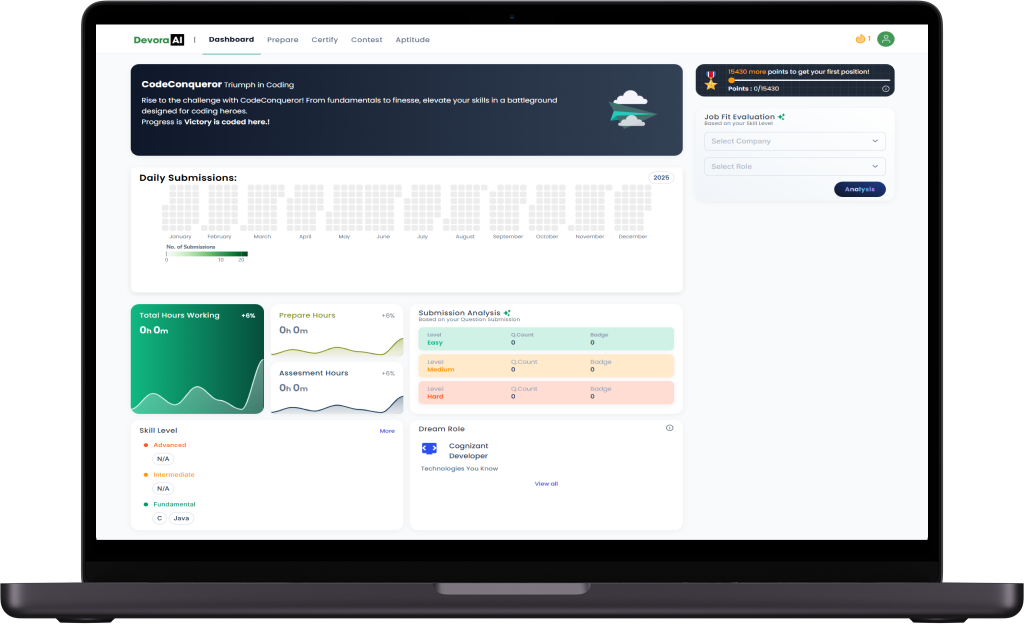
Our product provides real-time debugging assistance, allowing learners to efficiently identify and fix errors, enhancing their programming skills and understanding
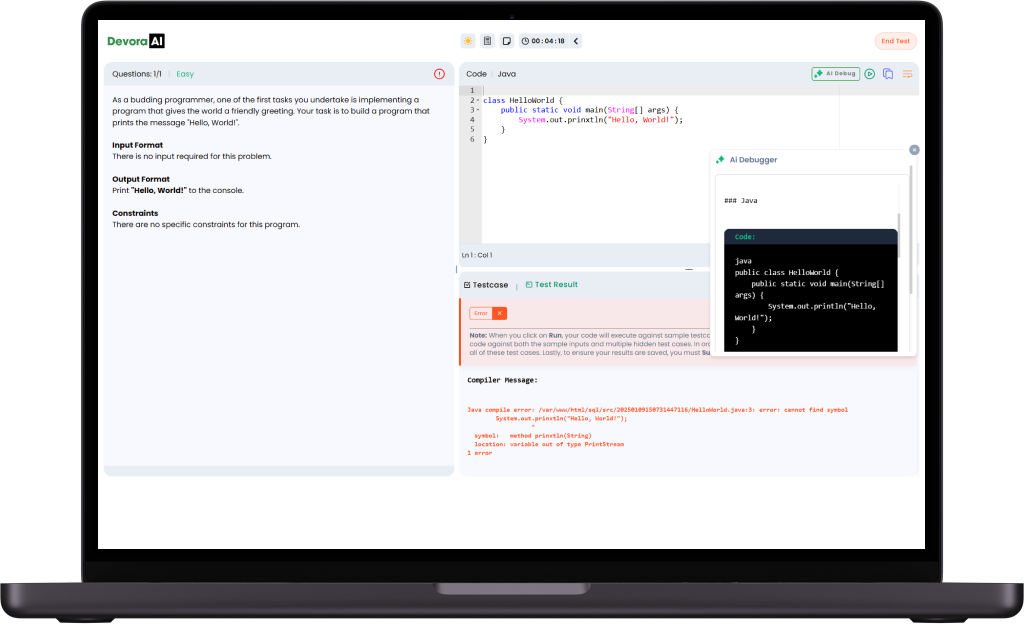
Our integrated IDE compiler offers a unified platform for writing, executing, and debugging code efficiently. With real-time execution and instant feedback, users can test and optimize their code seamlessly.
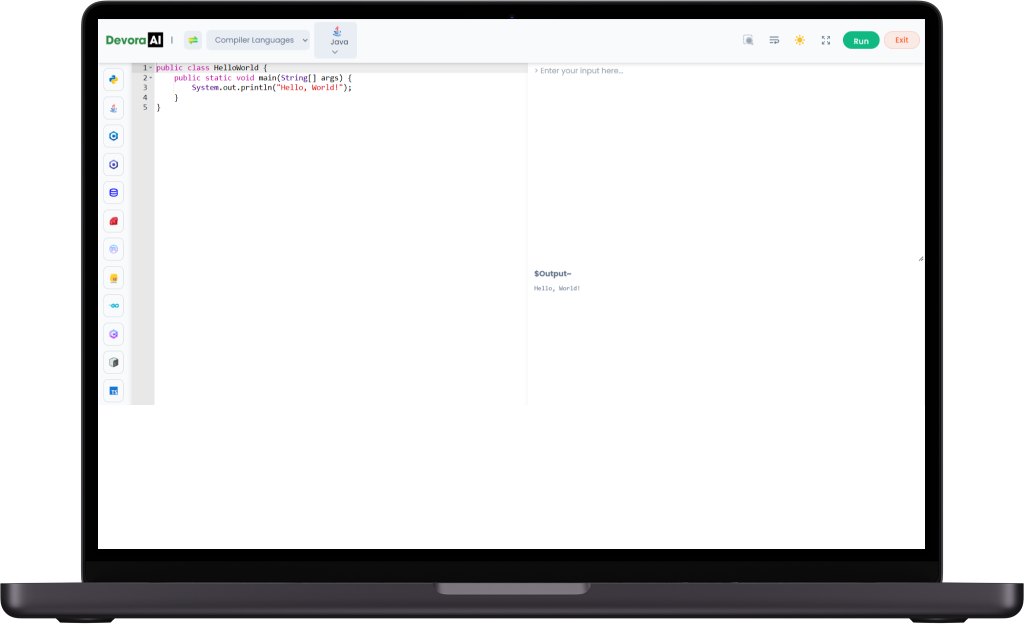
we organize coding contests within the platform, offering users the opportunity to compete against peers, test their problem-solving abilities, and enhance their skills through time-bound challenges and real-world scenarios
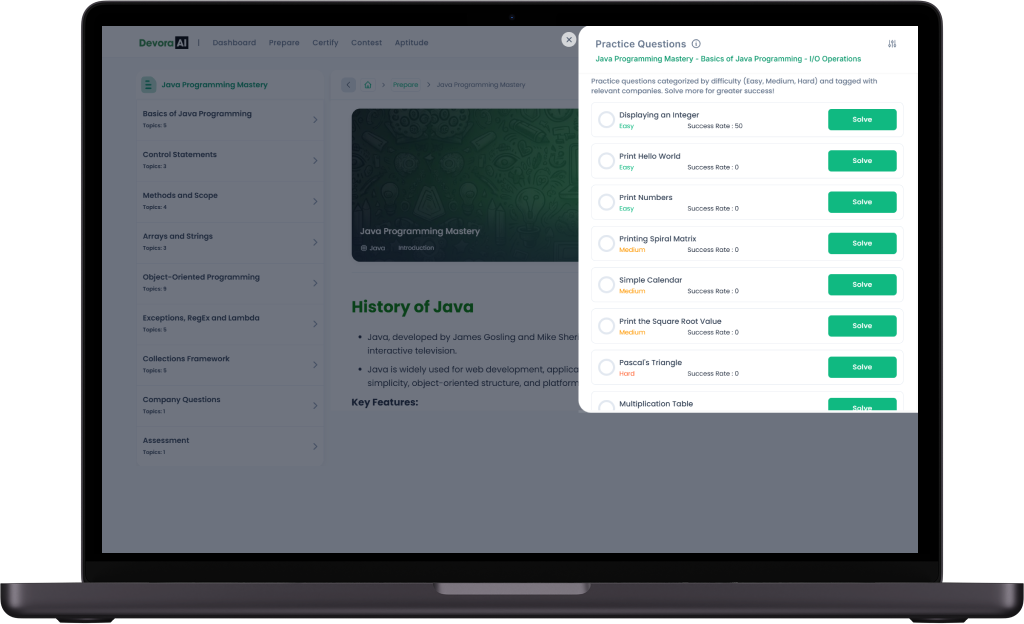
We maintain a personalized profile for each user, tracking their learning progress, performance in coding problems, and achievements,It also includes a record of completed contests, certifications earned, and coding skills developed etc
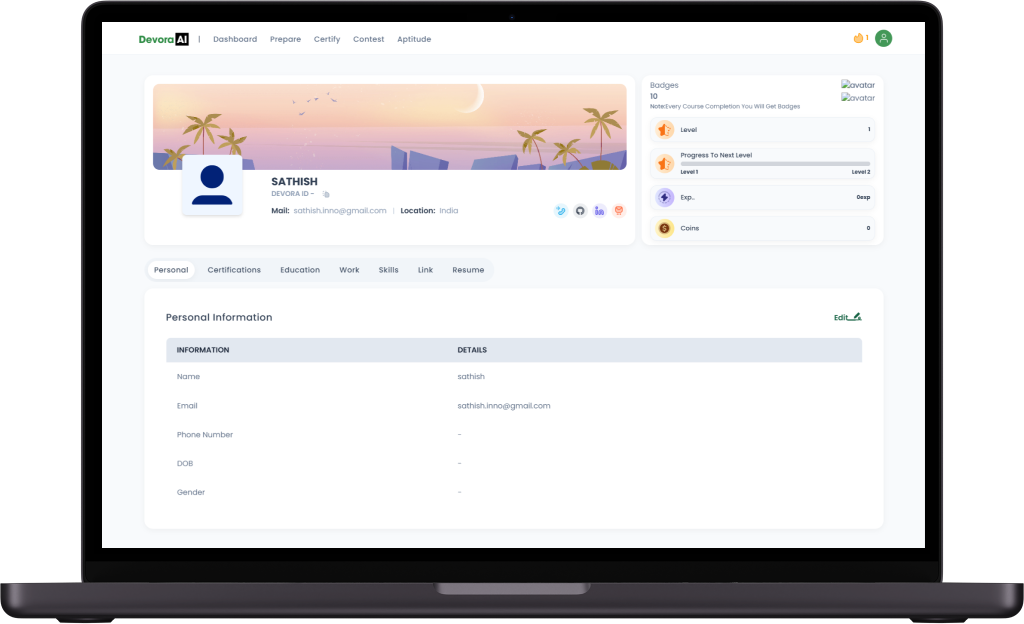
This is one For You
Hands on training
Looking to enhance your Coding skills
Innovation Ideas
lets you create innovative solutions, explore technologies
Newbie Programmer
Budding Programmer , Wants to learn some tricks and tips
Upskilling your skills
A professional wanting to Update their skills
Gain a Competitive Edge With Our Professional Certificates
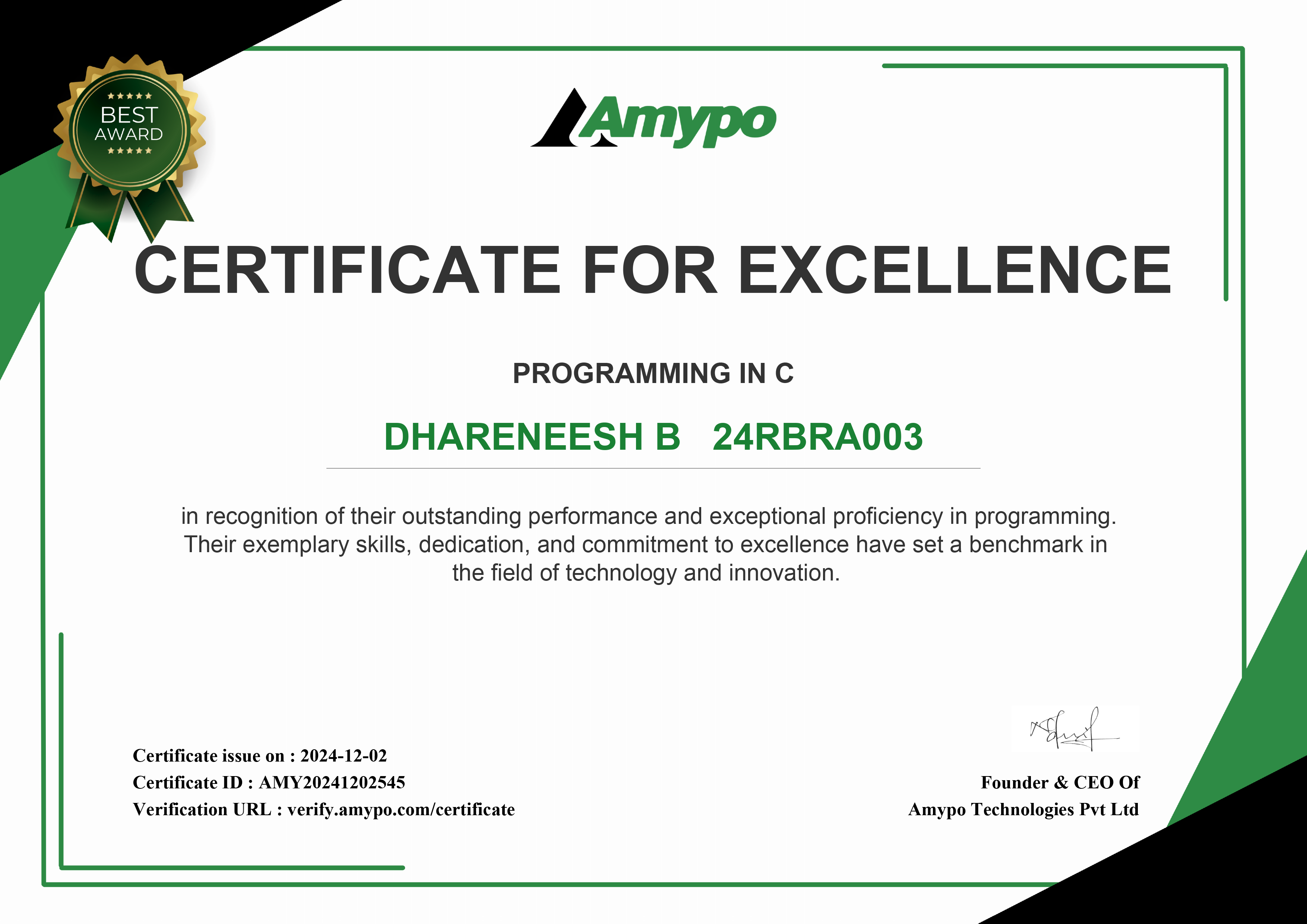
Master the latest programming languages and enhance your skill set with a recognized certificate.
unlock new career opportunities with a programming certificate


